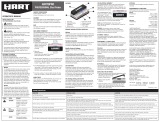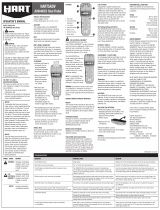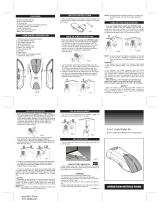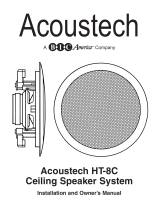
Electrical field locators may not detect
live AC wires if moisture is present
in the wall, or if wires are more than 51 mm from the
scanned surface, in plastic conduit or behind a plywood
shear wall or metallic wall covering. Do not rely exclusively
on the detector to locate items behind the scanned surface.
Use other information sources to help locate items before
penetrating the surface. Such additional sources include
construction plans, visible points of entry of pipes and
wiring into walls, such as in a basement, and in standard
16” and 24” stud spacing practices.
DO NOT ASSUME THERE ARE NO
LIVE ELECTRICAL WIRES IN THE
WALL. DO NOT TAKE ACTIONS THAT COULD BE
DANGEROUS IF THE WALL CONTAINS A LIVE
ELECTRICAL WIRE. ALWAYS TURN OFF THE ELECTRICAL
POWER, GAS, AND WATER SUPPLIES BEFORE
PENETRATING A SURFACE. FAILURE TO FOLLOW THESE
INSTRUCTIONS MAY RESULT IN ELECTRIC SHOCK, FIRE,
AND/OR SERIOUS INJURY OR PROPERTY DAMAGE.
8. OPERATING CAUTIONS
Depending on the proximity of electrical wiring or pipes to
the wall surface, the scanner may detect them in the same
manner as studs. Caution should always be used when
nailing, cutting, or drilling in walls, floors, and ceilings that
may contain these items.
To avoid surprises, remember that studs or joists are
normally spaced 16 in. (406 mm) or 24 in. (610 mm)
apart and are 1
1
⁄2 in. (38 mm) in width. Anything closer
together or a different width may not be a stud,
joist, or firebreak. Always turn off the power when
working near electrical wires.
9. SCANNING DIFFERENT SURFACES
Freshly painted walls: Must dry a minimum of one week
after application.
Wallpaper: Stud finder functions
normally on walls covered with
wallpaper or fabric, unless the
materials are metallic foil, contain
metallic fibers, or are still wet
after application.
Wallpaper may
need to dry for several weeks
after application.
Textured walls or acoustic
ceilings: When scanning a ceiling
or wall with an uneven surface,
place thin cardboard on the surface
to be scanned and scan over the
cardboard. Calibrate with cardboard
in place.
Wood flooring, subflooring,
or gypsum drywall over
plywood sheathing: Use the High
Sensitivity mode and move the tool slowly. The Signal
Strength Indicator may only display 1 or 2 bars when the
tool locates a stud through thick surfaces.
5. DIFFICULTY LOCATING A STUD?
TRY HIGH SENSITIVITY MODE
If you have difficulty locating a stud after
following Step 4, it could be that the stud
is deep or the walls are thick. With the unit
still placed flat against the wall and turned
on, quickly (within one second) release and
re-press the Power button. The Stud Scan
mode indication will flash continuously,
indicating that the tool has entered High
Sensitivity mode. The center of a very deep
stud will be
indicated by the
four middle bars
illuminating.
6. MARKING THE CENTER
OF THE STUD
Once an object is located, mark the location
where the SpotLite
®
Pointing System
illuminates. This is the center of the stud.
4. FINDING A STUD
Always start with the scanner placed flat against the wall,
then press the Power button. Wait for beep to confirm
calibration has completed before moving tool.
Slowly slide tool
across surface. EDGE
display will illuminate,
indicating location of
the stud edge.
Continue sliding tool.
When the center of
stud is located with
three bars on the Signal
Strength Indicator,
the buzzer will sound,
and the four middle
bars, CENTER display,
and SpotLite
®
Pointing
System will illuminate.
In cases of deeper studs
(or thicker walls) when
the center of the stud is
located, only two bars
will show on the Signal
Strength Indicator and
only the SpotLite
®
beam
and four middle bars will
illuminate. If you still can’t
locate a stud, try the next step.
The tool may detect other objects
behind the wall such as pipes and
conduit. See Section 8: Operating Cautions for ways to
confirm that you found a stud.
7. WIREWARNING
®
DETECTION
The WireWarning
®
detection works continuously. When
live AC voltage is detected, the WireWarning
®
detection
indicator will appear in the display.
If scanning begins over a live AC wire, the WireWarning
®
detection indicator will flash continuously.
Craftsman
®
Stud Finder
This Craftsman
®
stud finder detects both the
center and edges of wood and metal studs and
joists in walls, floors, and ceilings in one step.
It features a durable high-impact case and the
patented SpotLite
®
Pointing System. It also has
WireWarning
®
detection to continually detect
hot AC voltage when scanning for studs.
1. INSTALLING THE BATTERY
Press battery door release in with your finger or a coin
and lift up to remove door.
Place 9-volt battery into the compartment and press
into place.
Replace battery door and snap shut.
2. OPERATING TIPS
For optimum scanning results, it is important to properly
hold the stud finder and move slowly when scanning. The
following tips will provide more accurate scanning results:
•Graspthehandlewithyourthumbononesideand
your fingers on the other side. Make sure your fingertips
are resting on or above the running board and not
touching the surface being scanned or the scanning
head of the tool.
•Holdthetool
straight up and
down, parallel to
the studs, and do
not rotate the tool.
SpotLite
®
Pointing System
Signal Strength
Indicator
LCD Display
Battery
(back of unit)
Edge or Center
Indication
Auto Correcting
Indication
WireWarning
®
Detection Indication
Stud Scan Mode
Indication
Running Board
Power Button
•Keepthetoolflatagainstthewallanddonotrockor
tilt the tool when slowly sliding across the surface
being scanned.
•Avoidplacingyourotherhand,oranyotherpartofyour
body, on the surface being scanned. This will interfere
with the tool’s performance.
3. TURNING ON/CALIBRATING THE TOOL
•Placestudfinderflatagainstthewall,thenpressand
hold the Power button. The LCD will display all icons
until calibration is complete. Upon completion of
calibration, the SpotLite
®
Pointing System and buzzer
will momentarily activate and the tool will begin
continuous measurements.
Note: It is important to wait for calibration to complete
(1–2 seconds) before moving the scanner.
•ACT
™
(Auto Correcting Technology) — The tool will
automatically recalibrate itself when needed during
scanning. This recalibration is usually transparent and
no indication is made. If an arrow icon illuminates, the
tool was calibrated near or over a stud and then moved
away. The arrow indicates the direction of the
missed stud.
FCC Part 15 Class B Registration Warning
This device complies with Part 15 of FCC Rules. Operation is subject to the following two conditions: (1) this device may not cause harmful interference,
and (2) this device must accept any interference received, including interference that may cause undesired operation.
ACT,CenterVision,SpotLite,andWireWarningareregisteredtrademarksortrademarksofZirconCorporation.•P/N63030•RevB06/11
10. HELPFUL HINTS
WARNING
CAUTION
WARNING
All LCD segments
turn on at the
same time and
the unit beeps
continuously.
Detects other
objects besides
studs.
You suspect
electrical wires,
but do not
detect any.
Area of voltage
detection is
too large.
•Unitnotflatagainstwall.
•Unittiltedorliftedduringscan.(Allthese
factors affect proper calibration.)
•Scanningsurfaceistoodenseortoowet
for unit to operate.
•Electricalwiringandmetalorplasticpipes
may be near or touching back surface of wall.
•Wiresareshieldedbymetalconduit,abraided
wire layer, behind metallic wall coverings,
plywood shear wall, or other dense material.
•Wiresmaynotbelive.
•Wiresdeeperthan2in.(51mm)from
surface might not be detected.
•Voltagedetectioncanspreadondrywallas
much as 12 in. (305 mm) from each side of
an actual electrical wire.
•Onroughsurfaces,placepieceofpaperonwall,scanningthroughittohelpslideunitmoresmoothly.
•Keephandatleast6in.(152mm)fromthestudfinderwhileyoucalibrateandscan.Holdunitwith
thumb and index finger no higher than handgrips. Be careful not to move your fingers after calibration.
•Alwaysholdunitparalleltoandmoveperpendiculartoobjectyou’retryingtolocate.
•Ifyouareusingunitonarecentlytaped,painted,orwallpaperedwall,allowtimetodryandtryagain.
•Whileunitisstillon,quicklyreleaseandre-pressthePowerbuttontoenterHighSensitivitymode.
•Checkforotherstudsequallyspacedtoeitherside12,16,or24in.(305,406mm,or610mm)apart,
or check for the same stud at several places directly above or below the first finding. Studs will run
straight up and down from floor to ceiling, while pipes may change direction.
•Seeabovesolution.
•Useextracautioniftheareahasplywood,thickwoodbackingbehinddrywall,
or thicker-than-normal walls.
•Ifaswitchcontrolsanoutlet,makesureitisONfordetection,butturnedoffwhenworking
near electrical wires.
Always turn off the power when working near electrical wires.
•Tonarrowdetection,turnunitoffandonagainattheedgeofwherewirewasdetected
and scan again.
Probable Cause SolutionSituation
Lath & Plaster: Due to irregularities in plaster thickness, this tool is not recommended for use on lath & plaster.
Stud finder cannot scan for wood studs and joists through carpeting and pad. In Stud Scan mode, the stud finder will
NOT be able to scan through dense materials such as glass, ceramic tile, and foil.
Note: Sensing depth and accuracy can vary due to moisture content of materials, humidity, wall texture, and paint.
-
 1
1
Ask a question and I''ll find the answer in the document
Finding information in a document is now easier with AI
Related papers
Other documents
-
Eclipse 902-592 Owner's manual
-
 HART HART9PRO Owner's manual
HART HART9PRO Owner's manual
-
 HART HART5ADV Owner's manual
HART HART5ADV Owner's manual
-
Aktakom ACT-1210 User manual
-
Workzone 11334 User manual
-
Zircon 73190 Wood Stud SuperScan Advanced Stud Finder User manual
-
 Pittsburgh 92375 Owner's manual
Pittsburgh 92375 Owner's manual
-
Bosch Power Tools Multi-Detector DMD4 User manual
-
Niles HDLCR User manual
-
 Acoustech HT-8C Installation and Owner's Manual
Acoustech HT-8C Installation and Owner's Manual




